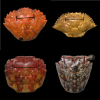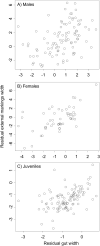Predicting diet in brachyuran crabs using external morphology
- PMID: 37065690
- PMCID: PMC10100828
- DOI: 10.7717/peerj.15224
Predicting diet in brachyuran crabs using external morphology
Abstract
Morphological traits have often been used to predict diet and trophic position of species across many animal groups. Variation in gut size of closely related animals is known to be a good predictor of dietary habits. Species that are more herbivorous or that persist on low-quality diets often have larger stomachs than their carnivorous counterparts. This same pattern exists in crabs and in most species, individuals exhibit external markings on the dorsal side of their carapace that appear to align with the position and size of their gut. We hypothesized that these external markings could be used as an accurate estimate of the crab's cardiac stomach size, allowing an approximation of crab dietary strategies without the need to sacrifice and dissect individual animals. We used literature values for mean diet and standardized external gut size markings taken from crab photographs across 50 species to show that percent herbivory in the diet increases non-linearly across species of brachyuran crab with the external estimate of gut size. We also used data from dissections in four species to show that external gut markings were positively correlated with gut sizes, though the strength of this correlation differed across species. We conclude that when rough approximations of diet quality such as percent herbivory will suffice, measuring external carapace markings in crabs presents a quick, free, non-lethal alternative to dissections. Our results also provide important insights into tradeoffs that occur in crab morphology and have implications for crab evolution.
Keywords: Diet composition; Diet quality; Gut size; Morphological variation; Nonlethal methods; Percent herbivory; Trophic position.
© 2023 Quezada-Villa et al.
Conflict of interest statement
The authors declare that they have no competing interests.
Figures







Similar articles
-
Using external morphology as a proxy for stomach size in Hemigrapsus sanguineus.Ecol Evol. 2024 May 2;14(5):e11344. doi: 10.1002/ece3.11344. eCollection 2024 May. Ecol Evol. 2024. PMID: 38698925 Free PMC article.
-
Predicting diet and consumption rate differences between and within species using gut ecomorphology.J Anim Ecol. 2011 Jul;80(4):854-63. doi: 10.1111/j.1365-2656.2011.01832.x. Epub 2011 Mar 21. J Anim Ecol. 2011. PMID: 21418211
-
Morphometric correlations between dietary and reproductive traits of two brachyuran crabs, Hemigrapsus sanguineus and Aratus pisonii.PLoS One. 2022 Aug 4;17(8):e0267369. doi: 10.1371/journal.pone.0267369. eCollection 2022. PLoS One. 2022. PMID: 35925929 Free PMC article.
-
Metagenomic analysis of gut microbiome illuminates the mechanisms and evolution of lignocellulose degradation in mangrove herbivorous crabs.BMC Microbiol. 2024 Feb 13;24(1):57. doi: 10.1186/s12866-024-03209-4. BMC Microbiol. 2024. PMID: 38350856 Free PMC article.
-
A review of feeding and nutrition of herbivorous land crabs: adaptations to low quality plant diets.J Comp Physiol B. 2007 Apr;177(3):269-86. doi: 10.1007/s00360-006-0138-z. Epub 2007 Feb 6. J Comp Physiol B. 2007. PMID: 17279390 Review.
Cited by
-
Using external morphology as a proxy for stomach size in Hemigrapsus sanguineus.Ecol Evol. 2024 May 2;14(5):e11344. doi: 10.1002/ece3.11344. eCollection 2024 May. Ecol Evol. 2024. PMID: 38698925 Free PMC article.
References
-
- Awruch CA, Frusher SD, Pankhurst NW, Stevens JD. Non-lethal assessment of reproductive characteristics for management and conservation of sharks. Marine Ecology Progress Series. 2008;355:277–285. doi: 10.3354/meps07227. - DOI
-
- Bada N, Da Ros Z, Rindi F, Busi S, Azzurro E, Derbal F, Fanelli E. Seasonal trophic ecology of the invasive crab Percnon gibbesi (Brachyura, Plagusiidae) in the southwestern Mediterranean: insights from stomach contents and stable isotope analyses. Marine Environmental Research. 2022;173(2):105513. doi: 10.1016/j.marenvres.2021.105513. - DOI - PubMed
-
- Baeta A, Cabral HN, Marques JC, Pardal MA. Feeding ecology of the Green crab, Carcinus maenas (L., 1758) in a temperate estuary, Portugal. Crustaceana. 2006;79:1181–1193.
-
- Barton PS, Gibb H, Manning AD, Lindenmayer DB, Cunningham SA. Morphological traits as predictors of diet and microhabitat use in a diverse beetle assemblage. Biological Journal of the Linnean Society. 2011;102(2):301–310. doi: 10.1111/j.1095-8312.2010.01580.x. - DOI
-
- Berumen ML, Pratchett MS, Goodman BA. Relative gut lengths of coral reef butterflyfishes (Pisces: Chaetodontidae) Coral Reefs. 2011;30(4):1005–1010. doi: 10.1007/s00338-011-0791-x. - DOI
MeSH terms
LinkOut - more resources
Full Text Sources

